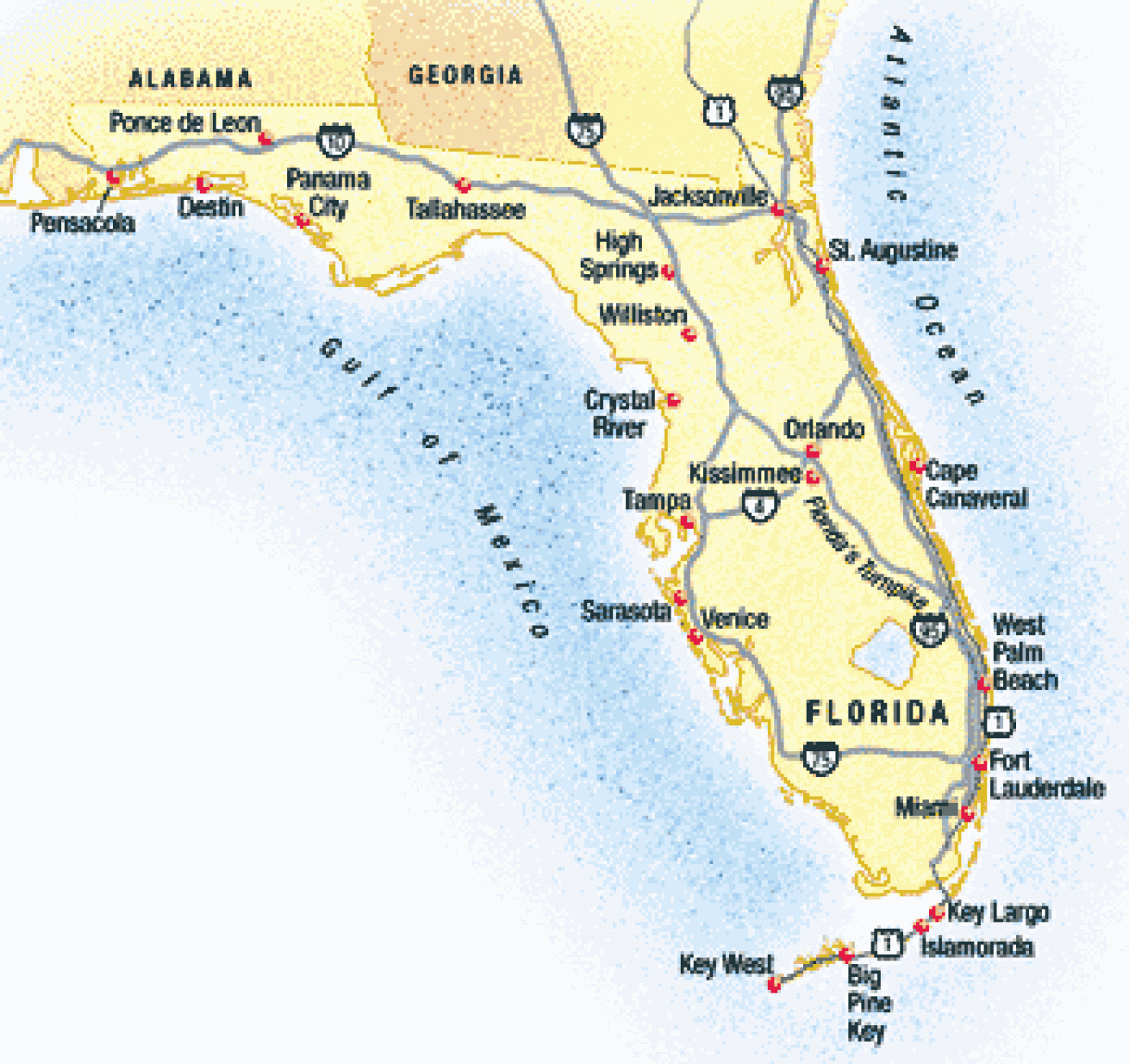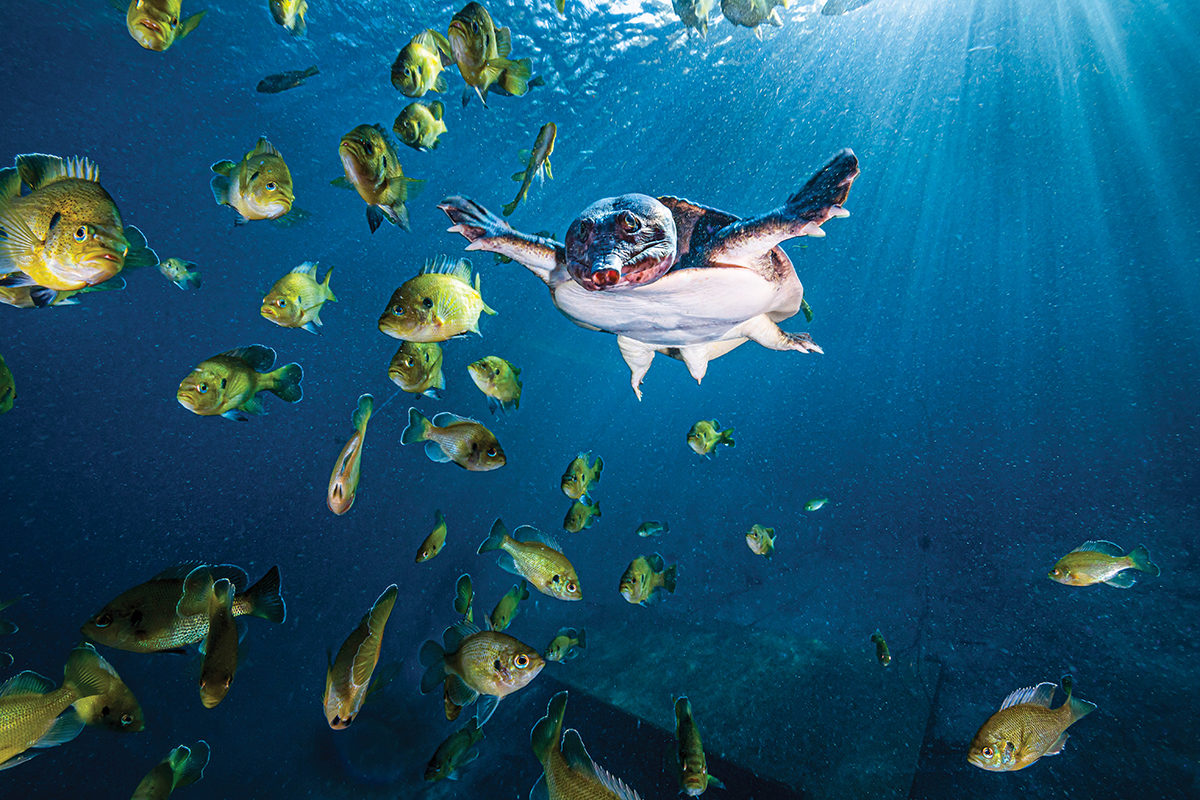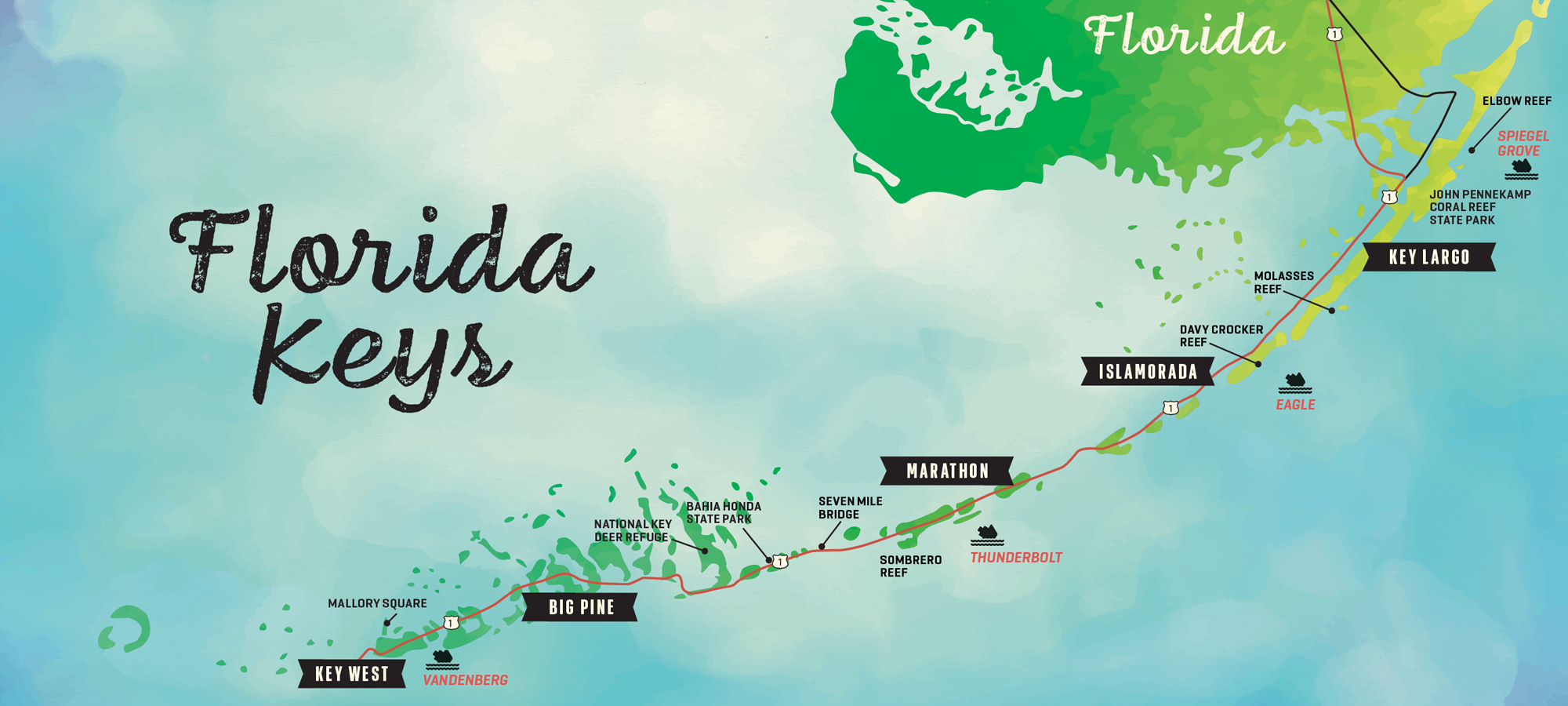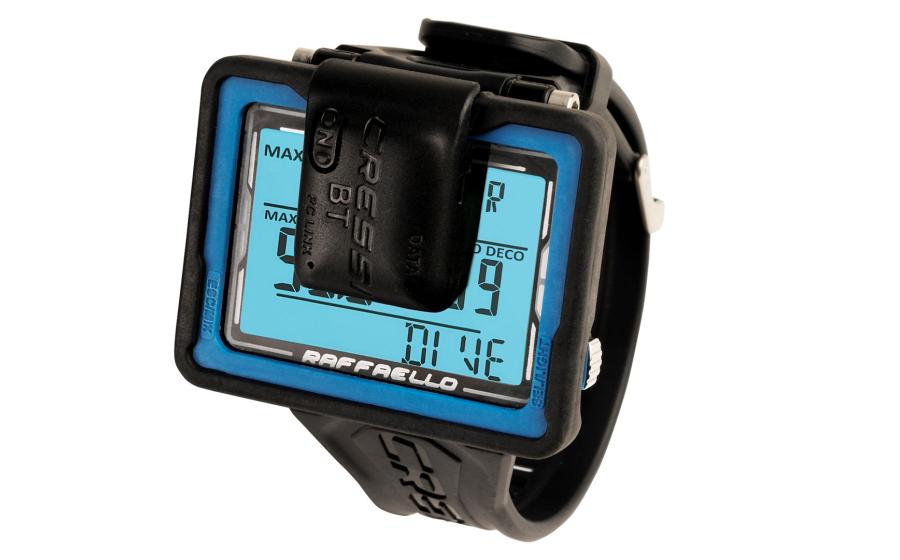Best Scuba Diving in Florida

ShutterstockScuba Diving The Sunshine State
From manatees in the freshwater springs to giant shipwrecks off the coast, Florida offers a little bit of everything.
It’s no mystery as to why Florida has as many scuba diving opportunities as alligators in the Everglades: The peninsula hangs like a fishing pole into the Gulf of Mexico and Atlantic Ocean, lapped by water on three (yes, three!) coasts and dotted within by warm springs that bubble up from the world's largest freshwater reserves.
This international dive hub is easily reached for American divers by air or interstate. All major carriers fly nonstop to cities like Jacksonville, Orlando, Tampa, Fort Lauderdale and Miami, and to any of Florida's medium-sized cities on a quick connection. With a rental car or your own wheels, you can visit the best scuba diving in Florida — from the Panhandle’s Oriskany to the reefs of the Keys — in one go, or wrap it into a multi-state road trip. Many of the country’s best dives are within reach of Florida divers and interlopers alike.

The Best Scuba Diving in Florida
Scroll down for more on each of these regions:
Scuba Diving In the Florida Panhandle

ShutterstockFlorida Panhandle
Experience warm gulf waters, mighty wrecks and more while scuba diving in the Florida Panhandle.
Pensacola
The enormous military presence in Pensacola has not only shaped the city's commerce, but its dive sites as well. Pensacola is home to the world's largest artificial reef, the 911-foot USS Oriskany, a former Essex-class US Navy aircraft carrier. Other wrecks include the USS Massachusetts, a 500-foot World War I battleship, the Russian freighter San Pablo, the Navy barge Camel, an A-7 Corsair that fell off the deck of the carrier USS Lexington, Vietnam-era tanks and various Navy Diving Operations ships. There are also "grouper ghetto" pyramid-shaped concrete structures that lure tons of fish, as well as shore diving from the jetty.
Destin
Nestled between Pensacola and Panama City, Destin revels in its luscious stretches of prime Panhandle beach. Offshore, divers immerse themselves in the warm Gulf water at sites that include typical limestone ledges covered in corals, sponges and fish. Sunken barges, tugs, liberty ships, landing craft, airplanes, army tanks and bridge rubble are populated by grouper, flounder and cobia. Shore diving the Destin jetties at high tide is also possible.
Panama City
Long popular with the beachcombing and Spring Break sets, Panama City also draws its share of divers. An aggressive artificial reef program spearheaded by the Panama City Marine Institute that dates back to the '70s has sent ships, Navy scrap metal, pontoons, towers, bridge spans, tanks, hovercraft and even a Quonset hut to the bottom of the Gulf. Operations in Panama City also make the long trek out to the Empire Mica, the 465-foot British tanker that was torpedoed by a German U-boat in 1942. It now rests in 110 feet of water 20 miles off Cape San Blas.
Vortex Spring
Almost 30 million gallons of fresh water bubble up from beneath the surface of the Florida Panhandle each day at Vortex Spring, one of the state's westernmost freshwater dives. Swim with river catfish, harmless American freshwater eels and koi carp in the spring. Scuba divers have access to a large basin and two 55-foot-long artificial caverns. Both ends are open, making the passages safe for open-water divers. A buoyed line leads from the center of the basin down to the natural cavern entrance at 60 feet--the limit of safe penetration for all but certified cavern divers. Show your credentials, and you're allowed to penetrate 65 feet into the passageway that leads to the cave, but turn around when surface light is no longer visible. A measly $25 buys you an entire day of diving, and air fills are four bucks.
Dive Info For the Florida Panhandle
Water Conditions April through October is perhaps the best time to dive Florida's Panhandle, when visibility hovers around 50 feet, but sometimes 100 feet is possible. Water temps peak in the mid-80Fs in summer, but can drop to the high 50Fs in winter. In Vortex Spring, water temps are a constant 68F year-round and visibility a mind-blowing 200 feet.
How To Get There I-10 passes right through the heart of the Panhandle, and most towns are within a half-hour of the Interstate.
Scuba Diving In Northeastern Florida
Jacksonville
The continental shelf lies far offshore, so depths rarely dip below recreational scuba diving limits. In addition to fish-packed limestone ledges, you can dive the 327-foot landing craft Casablanca, sunk in 1972 in 85 to 110 feet of water, and the 225-foot freighter Anna, which went down in 1986.
St. Augustine
Just off America's oldest city lies one of the country's most unlikely landing strips, where 33 decommissioned Navy A-6 attack bombers have come to rest. The jets, which flew combat during the Persian Gulf War, now lie in 110 feet of water 24 miles out from St. Augustine Inlet. Other sites include fish-attracting artificial reefs composed of old concrete culverts, as well as Nine Mile North, a limestone ledge that runs from Jacksonville to Daytona. It's just a short drive away for anyone staying in New Smyrna Beach condo rentals.
Dive Info For Northeastern Florida
Water Conditions Summer is ideal for water temperatures off Jacksonville and St. Augustine — soaring to the low 80Fs — and vis, which ranges from 20 feet to up to 100 feet well offshore, averages around 50.
How To Get There I-10 from points west and I-95 from the north and south.
Scuba Diving On Florida's Gulf Coast
Sarasota
Three to five miles off the high-rise condos of Sarasota lie limestone ledges that provide an excellent structure for Gulf fish. Thirty miles beyond is the wreck of the Bay Ronto, which sits upside down in 100 feet of water. The 11,000-ton British steamship was sailing a load of wheat from Galveston, Texas, when a hurricane put her down in 1919. Fortunately, all of her crew made it to lifeboats before she sank. The wreck is an oasis of fish life in a vast desert of sand, where snapper flow in and out of cracks in the hull. Portions of the interior have collapsed, making penetration unwise.
Venice
Few sites in the world provide you with the opportunity to find things that could pay for the diving, short of illegally stripping an historic shipwreck. The ancient riverbed about a mile off Venice — shark tooth capital of the world — is one such place, where you can find enormous sharks' teeth that can fetch hundreds of dollars. It's only slightly clearer than braille diving, but the 10 feet of average visibility is enough to scour the bottom for the prehistoric choppers. And even if you don't bag a "charter tooth" — a tooth worth enough to pay for your dive trip — you'll probably still find enough little ones to make a keepsake necklace. What ancient shark teeth will you find?
Dive Info For the Gulf Coast
Water Conditions Water temps at dive destinations in this part of the Gulf of Mexico are typically warmer than their Atlantic counterparts, often peaking in the mid-80Fs in summer, but temps can drop to the mid-60Fs in winter. Visibility averages 25 to 50 feet, but can exceed 100 in summer and at remote offshore sites.
How To Get There Sarasota and Venice are a quick hour to an hour-and-a-half south of Tampa and St. Petersburg.
Scuba Diving In Central Florida

ShutterstockSwim With The Manatees
Have a big-animal encounter with the sweet hearts of the sea and go visit Florida's manatees.
Ginnie Springs
Why would you pay a couple bucks for a small bottle of spring water in a convenience store when you can scuba dive into one for less than 30? Dannon bottles its spring water at Ginnie Springs — an awesome endorsement for the quality and clarity of these waters. Ginnie Springs, a 100-foot-diameter depression, and three smaller springs —Devil's Eye, Devil's Ear and Little Devil — feed the tannin-dyed Santa Fe River with warm, clear water.
Devil's Den
Thousands of years ago, this cave's roof collapsed and opened up what's called a "karst window." Early settlers thought the steam rising off the spring-fed cave water looked like the smoke of hell —hence the name. Modern man knows better, and scuba divers, snorkelers and swimmers walk down steps from this window to enjoy the basin 60 feet below. The water's depths range from 50 to 65 feet. The cave system in the deeper area of the basin has been gated off, but there are several ambient-light swim-throughs.
Blue Grotto
There aren't too many places left in this world where you can dive all day for under 30 bucks. Blue Grotto is one such place, the largest clear-water cavern in Florida. You don't have to be cave- or cavern-certified, and you can reach a max depth of 100 feet and you're all but guaranteed to run into Virgil, the spring's resident Florida softshelled turtle . A compressed air-supplied bell at 30 feet allows you the don't-try-this-in-Cozumel opportunity of taking the regulator out of your mouth mid-dive and talking to your buddy.
Crystal River
This is sea cow central. The King's Bay area is a major mecca for manatees, which congregate here en masse November through April, when they swim in from the Gulf of Mexico to stay warm. Despite their size — adults average 10 feet in length and 1,000 pounds--manatees actually have very little body fat. The gentle creatures are protected by seven sanctuaries and one national wildlife refuge. You can't dive with the manatees — only snorkel — and harassing or chasing them is strictly prohibited.
Rainbow River
Take a drift down this 5.7-mile river in Dunnellon, Florida. Over 400 million gallons of freshwater are discharged from the springs everyday which gives this river an average speed of 1.5 knots and up to 200 feet of visibility. The shallow water will take you on a lazy-river-ride past boat docks filled with silvery fish, prairies of aquatic grasses filled with turtles, and more all while anhingas dive bomb looking for fish and curious bluegills get up close. Here's what you need to know about scuba diving in Rainbow River
The Living Seas at Epcot
The last place you'd ever think about bagging a dive is at a major theme park, but you can get one in at Disney World. For 179 bucks you can slip into Epcot's Living Seas aquarium for a half-hour and get mask-to-snout with sharks and tropical fish while your Mickey-eared kids witness you in action. But don't pack your duffel just yet — they make you use their equipment, presumably to prevent your funky gear from contaminating their tank. Only 16 people get to dive it each day, so book it early. Read what it's like to go scuba diving in an aquarium.
Dive Info For Central Florida
Water Conditions Typically, central Florida's spring-fed waters are a constant 72F, but can sometimes drop to 68F. One of the strong suits of diving here is the visibility--in most cases reaching the limits of human vision. Expect 200 feet or more. The water in the Living Seas tank is kept at a constant 74F to stunt algae growth.
How To Get There All major air carriers serve Orlando's airport, and most Central Florida spring dives are within an hour or two hours' drive.
Scuba Diving In South Florida

Courtesy southfloridadiving.comDive With Lady Luck
The Lady Luck is one of the many artificial wrecks added along shores of Palm Beach County.
West Palm Beach
Gulf Stream-powered drift diving is the name of the game in West Palm; in fact, the world's second-largest ocean current flows as fast as 70 miles a day just one mile offshore. Breakers Reef is a two-mile-long stretch of shallow coral reef that's populated by Caribbean tropicals, green morays, spiny lobster and the occasional pelagic. There's also the Corridor, a collection of "shipreefs" just 10 minutes from Palm Beach Inlet that you can dive on a single tank. The Corridor includes the 185-foot Greek luxury liner Mizpah in 90 feet of water, the PC1170, a retired 165-foot patrol boat that sits off her bow, and a path of rubble that leads to the Amaryllis, a 441-foot freighter that slammed into Singer Island in 1965. Here's how to plan a dive trip to West Palm.
Fort Lauderdale
Crisscrossed by navigable canals, the "Venice of America" is a city obsessed by water and watersports, and this passion doesn't end at the beach. An aggressive artificial reef program has sent not only dozens of wrecks to the seafloor, but also three retired oil platforms called Tenneco Towers. The rigs are covered in corals and sponges and populated by grunts, snapper and the occasional bull shark.
Miami
Perhaps better known for flamboyant South Beach and haute couture, Miami has a double life as an oft-overlooked dive mecca. Lined up stern to bow, the city's wrecks could stretch more than two-and-a-half miles. Miami's Wreck Trek is a cluster of sites that can be dived in a single tank — two if you want to see more. Sites include the Miss Patricia, a 65-foot steel tug, two M60 tanks, the 110-foot Billy's Barge, Ben's Antennae Reef and the Miss Karline, a 100-footer lodged in the sand almost within sight of the Patricia. But perhaps the biggest attraction of Miami's wreck scene is The Spirit of Miami, a retired Boeing 727 that made its final landing off Key Biscayne.
Dive Info for Southeastern Florida
Water Conditions Water temps in southeastern Florida range from the mid-70Fs in winter to low 80Fs in summer, while visibility is generally in the sub-100-foot range.
How To Get There Miami and Fort Lauderdale are easily reached by all major airlines. If you're driving, I-95 will get you there.
Scuba Diving In the Florida Keys
Key Largo
Even without shipwrecks, the colorful reefs and mind-numbing profusion of fish life in Key Largo would be reason enough to pack up the family truckster and drive on down. But now, the 510-foot Spiegel Grove gives the area an added attraction. After eight years of planning and a nail-biting sinking that had the Grove floating upside down on CNN, the wreck is starting to attract more marine life than attention. You'll find fish like barracuda, jacks and silversides have made this wreck their homebase. Read more about the wrecks and reefs of Key Largo.
Islamorada
Two great wrecks can be found off the saltwater fly-fishing capital of the world, the Eagle and the Cannabis Cruiser. The Eagle is much bigger, a 269-foot Dutch freighter that sank in 1985. Her hull was split in two major chunks by Hurricane Georges in 1998 and lies in 70 to 110 feet of water. Resident Islamorada fish include tarpon and goliath grouper. The charges used to sink the Eagle blew diver-friendly penetration holes in her hull. The shrimper-turned-drug runner known locally as the Cannabis Cruiser was scuttled as the Coast Guard closed in. She now rests in 100 feet of water, where thick schools of mangrove snapper and a huge jewfish populate the site.
Big Pine Key
Big Pine Key makes a great base for exploration of one of the Lower Keys' greatest wrecks, the Adolphus Busch Senior. The 210-foot freighter was intentionally sunk in '98 in 50 to 105 feet of water. Along with Jack Lemmon, it co-starred in the 1957 movie "Fire Down Below." The Looe Key Artificial Reef Association bought the former Ocean Alley and towed it from Haiti. She was cleaned up and rechristened after the malt beverage magnate.
Key West
Stay sober long enough in Key West and you can dive one of the coolest wrecks in the country. The 187-foot steel-hulled buoy tender Cayman Salvager transported Cuban refugees during the Mariel boatlift in the late '70s and early '80s. The wreck is now packed with marine life, including permit, Nassau grouper, reef octopus and hawksbill turtles. Divers rejoiced that day in 1985 when--while being towed far offshore-- she prematurely went down in 90 feet of water. No visit to Key West would be complete without taking a dive on the 520-foot artificial reef made up of the former USNS Vandenberg.
Dive Info For the Florida Keys
Water Conditions Though year-round diving is possible, the Keys are perhaps best dived spring through fall, when visibility is best, water temps peak in the mid-80Fs, and weather conditions allow a better chance of visiting the good sites.
How To Get There The Keys start less than an hour south of Miami on US 1.












